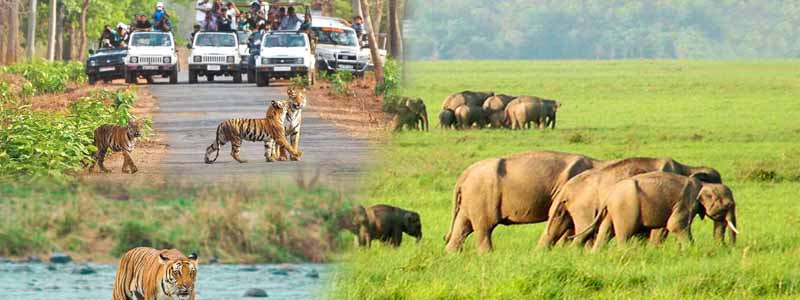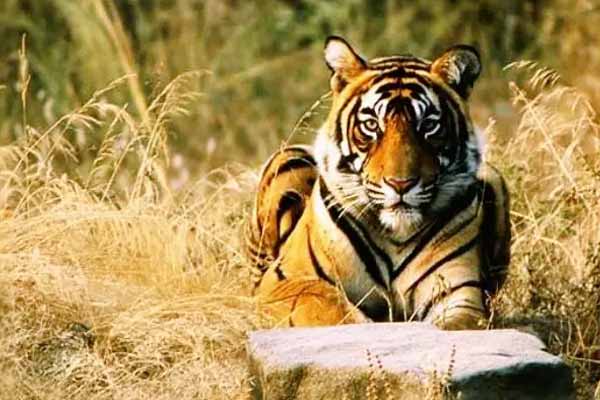Wildlife Safari Experience India, The vicious tiger lurks behind the dense bamboo bushes, eagerly waiting for its prey. The screeching of an eagle sometimes disturbs the meditative trance of the sky above. A herd of deer visits the nearby water hole to quench their thirst in the distance, whilst the sly crocodile remains motionless, waiting for the right moment to strike.
These are some of the sights you’ll see if you go on a jungle safari in India‘s thick forests. This safari is unlike any other, with plenty of surprises and thrills. Seeing nature’s inhabitants in their natural environment, expressing raw feelings, is nothing short of a blessing. This blog is for anyone who has ever had a dream to observe Wildlife Safari Experience India. We’ll tell you where to go on a jungle safari in India to see the best sights and sounds of the natural world.
It’s important to know the dos and don’ts of going on a wildlife safari in India as a beginner. At the same time, you should have a list of places in India that offer the best wildlife safaris. Many of these questions are answered in this beginner’s guide to wildlife safari experiences India:

Jim Corbett National Park
Jim Corbett National Park It is India’s oldest national park, situated in Uttarakhand’s Nainital and Pauri Garhwal districts. It was originally called Hailey National Park when it was established in 1936, but was later renamed after renowned hunter and naturalist Jim Corbett. It was the first park to be included in Project Tiger, and it is now one of the world’s most popular ecotourism destinations. More than 70,000 people visit Jim Corbett each year, which is home to 488 different species of plants. There are 25 reptile species, 580 bird species, and 50 mammal species among the fauna.
This park is more spectacular because of its varied geographical features, which include a massive lake, grasslands, marshy depressions, riverine belts, and hills. The park covers a total area of 520.8 km2 (201.1 sq mi), with elevations ranging from 1300 to 4000 feet. Apart from Bengal tigers, the park is home to rhesus macaques, langurs, Indian pangolins, Himalayan goral, yellow-throated martens, otters, Indian grey mongoose, Himalayan black bears, sloth, chital, hog deer, sambar deer, barking deer, leopards, and sloths, leopard cat, fishing cat, jungle cat, Indian elephants, crocodiles, gharials, Indian python, and a great range of birds as well, Wildlife Safari Experience India.
Bandhavgarh National Park
Bandhavgarh National Park is a 716-square-kilometer national park in Madhya Pradesh’s Umaria district. In 1968, it was designated as a national park, and in 1993, it was designated as a Tiger Reserve. The name of this park is based on a legend that it was named after a prominent hillock in the city that served as a vantage point for Lakshmana who was assigned to keep an eye on Lanka by his brother, Lord Rama. The park is known for its biodiversity and for having India’s highest tiger population density (8 tigers per square km). It also serves as a haven for a variety of mammals, birds, reptiles, and butterflies.
Other animals found in this park include the Indian leopard, chital, nilgai, Indian wolf, striped hyena, caracal, nilgai, barking deer, and sambar, as well as 350 different species of birds. During the rainy season, the diversity and abundance of grasslands attract a significant number of sarus cranes and other migratory birds. Bandhavgarh is located in the deciduous forests in the Deccan Peninsula (Zone 6A). In the flora, dense bamboo thickets can be found among Dhobin, Salai, Saja, and Sal. The Maharaja Martand Singh of Rewa captured a white tiger called Mohan in 1951, and its taxidermic statue can still be seen here, Wildlife Safari Experience India.
Ranthambore National Park
Ranthambore is one of the most prominent ecotourism destinations in northern and western India, with a total area of 1334 square kilometres. According to its history, the Sawai Madhopur Game Sanctuary was founded by the Indian government in 1955. In 1973, it became a part of Project Tiger, and in 1980, it was designated as a national park. It was expanded in 1922 to include two neighbouring sanctuaries, the Keladevi and Sawai Man Singh sanctuaries. The park is well-known for its well-planned conservation of Bengal tigers, and it also makes big cat sightings fast and easy, Wildlife Safari Experience India.
Apart from tigers, there are also chital, mugger crocodiles, and rhesus macaques to be seen, Gray langur of the southern plains, sloth bear, striped hyena, sambar, wild boar, nilgai, Indian leopard, and various reptiles and birds It is also home to one of India’s largest banyan trees and is bordered on the north by the Banas River and on the south by the Chambal River. It was where ‘Machli‘ lived In the history of wildlife, she is the most prominent and oldest-living tigress. It continues to be an ideal breeding ground for a variety of species with diverse flora, and the officials’ contributions in the discussion are also commendable.
Sundarbans National Park
Because of its features, this national park has been designated as a Ramsar site, a UNESCO World Heritage Site, a biosphere reserve, and a tiger reserve. It is one of the world’s largest Bengal tiger reserves, and its thick mangrove forests support a diverse range of species. Many invertebrate animals, as well as saltwater crocodiles, call it home, birds, and other reptiles. The park’s existence dates back to the 19th century, when the Forest Act designated a significant portion of the mangrove as a reserved forest. In 1973, it was designated as a tiger reserve, then a wildlife sanctuary in 1977, and finally a national park in 1948, Wildlife Safari Experience India.
The park’s total area is currently 16,900 square kilometres (6,526 square miles), with a large portion of the delta situated in Bangladesh. The avifauna and aquatic fauna of Sundarban are well-known. Whistling teals, white-eyed pochards, northern pintails, golden plovers, curlews, eastern knots, little stints, black-tailed godwits, Eurasian whimbrels, pariah kite, water hens, openbill storks, and other birds can be seen here.It also supports a number of endangered marine mammals, including Ganges river dolphins, Irrawaddy dolphins, finless porpoises, and others.
Gir National Park
This reserve, also known as Gir National Park and Wildlife Sanctuary, was established in 1965 and is located in the Khathiar-Gir dry deciduous forests ecoregion. The forest covers a total area of 1412 km2 (545 sq mi) and is divided into three regions: Amreli, Junagadh, and Somnath. The park is closed every year from 16 June to 16 October, which is the perfect time for wildlife photography Between the months of April and May, a safari is recommended. However, since the heat can be too much for others, the best time to visit Sasan Gir is between the months of December and March.
It is the only location in Asia where Asiatic lions can be seen, and their population has been increasing at a rapid pace in recent years. Gir, like any other nature sanctuary, has a diverse range of flora and fauna. Banyan, chalam, kalam, sirus, amli, umlo, karanj, and several other broadleaf trees can be found here. The park produces around 5 million kilogrammes of green grass, valued at Rs. 500 million (US$7.12 million). You will see a honey badger, ruddy mongoose, leopards, jungle cats, hyenas, Bengal fox, desert cats, golden jackal, and a variety of other birds, insects, and reptiles in addition to Asiatic lions.
Kaziranga National Park
Kaziranga National Park is a UNESCO World Heritage Site that is home to two-thirds of the world’s great one-horned rhinoceroses as well as a high concentration of tigers. The park is divided into three districts and lies on the outskirts of the Eastern Himalaya biodiversity hotspot. It was designated as a Tiger Reserve in 2006 and is home to swamp deer, wild water buffalo, and elephants. Kaziranga Wildlife Reserve outperforms all other wildlife reserves in terms of upkeep and protection of protected areas, and it is also designated as an Important Bird Area by BirdLife International. Herbivores can find plenty of food in the dense tropical broadleaf forests and marshland.
It was designated as a reserve forest in 1905 and has been the subject of numerous films, songs, and books. The park was only 232 km2 (90 sq mi) when it was established; today, the official area recognised by the government is 430 km2 (166 sq mi). Floods often strike the city, claiming the lives of many animals each year. However, after the water recedes, the wildlife’s resilience becomes apparent. Every year, the park attracts a large number of visitors and astounds them with its biodiversity. Multiple water sources, swamps, open jungle, short and tall grasses, and a wide range of birds, mammals, reptiles, and insects make up the landscape.
